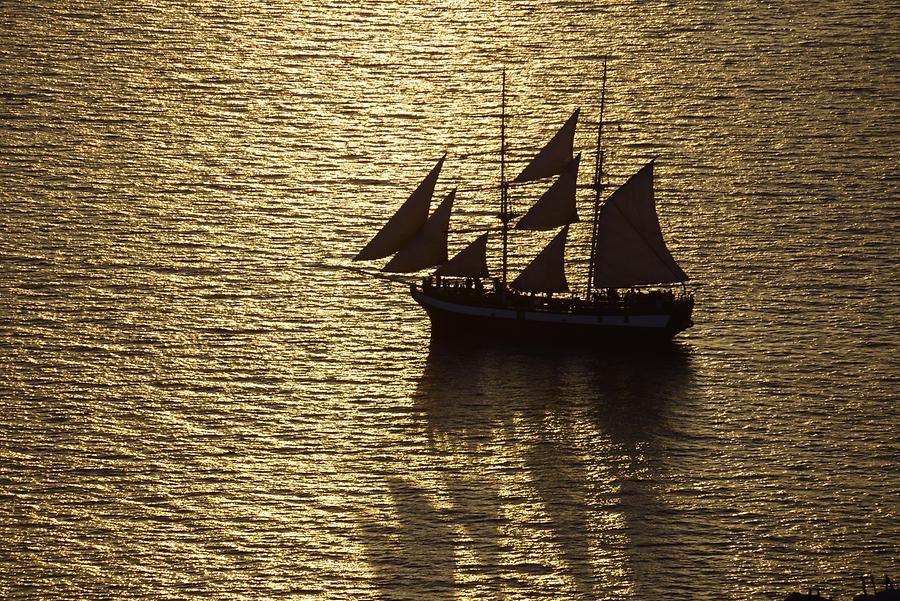Sailing Vessel#

Santorin gehört gemeinsam mit Mykonos, Naxos, Paros und Ios zum Inselbogen der Kykladen. Die Eilande sind die Reste eines ertrunkenen Faltengebirges, das einst Kleinasien mit dem Balkan verband. Vor 1,6 Millionen Jahren bestand auch Santorin hauptsächlich aus dem Profitis Illias, einem Berg aus Kalk und Marmor, der recht einsam aus dem Meer ragte. Dann begannen am Meeresgrund vulkanische Aktivitäten, ausgelöst durch eine Subduktionszone zwischen afrikanischer und ägäischer Kontinentalplatte. Ständige Eruptionen formten den Inselbogen der Kykladen neu und Santorin lag genau über dem Hot Spot. Das Herz der Insel bildete ein 1700 m hoher Vulkankegel, dem heutigen Vesuv nicht unähnlich. Doch die Unterwelt kam nicht zur Ruhe. Zahlreiche Explosionen zerrissen die Insel immer wieder und formten riesige Calderen. Der letzte gigantische Ausbruch erschütterte das Mittelmeer vor 3600 Jahren. Mindestens 60 km³ Lava und Staub ergossen sich über Santorin, mehr als doppelt so viel wie bei der Explosion des Krakatau. Eine 30 km hohe Rauchsäule erstreckte sich bis in die Stratosphäre. Die Asche verteilte sich über einen Radius von 1500 km, vom Nildelta über Anatolien bis zum Schwarzen Meer. Zudem verwüstete ein Tsunami zahlreiche Küstensiedlungen im östlichen Mittelmeerraum. Besonders betroffen war die Nordküste Kretas, das Zentrum der Minoer. Die Ureinwohner Kretas hatten die erste Hochkultur Europas geschaffen. Die älteste Epoche reicht 4700 Jahre zurück und bestand parallel zu den ersten Pharaonendynastien Ägyptens. Gerade als sich um 1620 v.d.Z. die Katastrophe unter Santorin zusammen-braute, befand sich die minoische Kultur am Höhepunkt und beeinflusste den östlichen Mittelmeerraum von Sizilien bis Kleinasien. Ein dichtes Seehandelsnetz sorgte für Wohlstand. Doch dann kam die Santorin-Apokalypse. Sie führte zu einer schweren Zäsur, nicht jedoch zum unmittelbaren Untergang der minoischen Kultur. Die überschwemmten Küstensiedlungen wurden wieder aufgebaut, doch die Glanzzeit war vorbei, weil die Vernichtung des minoischen Handelsstützpunktes von Akrotiri auf Santorin den Fernhandel erheblich einschränkte. So wurde der schleichende Niedergang der ersten europäischen Kultur letztlich doch durch den Vulkanausbruch eingeleitet. Vor der Katastrophe war das minoische Akrotiri eine blühende Handelsmetropole, eine der ersten europäischen Städte überhaupt. Manche Archäologen setzen sie sogar mit dem sagenhaften Atlantis gleich. Weil Erdbeben den Vulkanausbruch angekündigt hatten, verließen die Bewohner rechtzeitig die Insel und kehrten erst 600 Jahre später wieder zurück. Im 9. Jh. v.d.Z. kamen Dorer und Sparter vom griechischen Festland. Sie bauten die Insel, die damals Thera hieß, zum Marinestützpunkt aus. Während der klassischen Antike war Thera ein unabhängiger Stadtstaat, gelangte später unter Athener Einfluss und – nach Zerfall des Alexanderreiches – unter ptolemäische Herrschaft. Es folgten Römer, Byzantiner, Venezianer, Osmanen und schließlich wieder die Griechen. Neben Handel sicherte Wein den Santorinis einen beträchtlichen Wohlstand.
Santorin belongs to the archipelago of the Cyclades together with Mykonos, Naxos, Paros and Ios. The islands are the remains of drowned fold mountains that once connected Asia Minor with the Balkans. Santorin was mainly made up of Profitis Illias 1.6 million years ago. This mountain of limestone and marble stood out of the sea quite lonely. Then, at the bottom of the sea, volcanic activity started, triggered by a subduction zone between the African and Aegean continental plates. Constant eruptions reshaped the archipelago of the Cyclades and Santorini was right above the hot spot. The heart of the island formed a 1700 m high volcanic cone, not unlike today's Vesuvius. But the underworld did not calm down. Numerous explosions tore the island apart again and again and formed huge calderas. The last gigantic eruption shook the Mediterranean Sea 3600 years ago. At least 60 km³ of lava and dust spilled over Santorini, more than twice as much as in the Krakatau explosion. A 30 km high smoke column extended into the stratosphere. The ashes were distributed over a radius of 1500 km, from the Nile Delta over Anatolia to the Black Sea. In addition, a tsunami devastated numerous coastal settlements in the eastern Mediterranean. Particularly affected was the north coast of Crete, the center of the Minoans. The natives of Crete had created the first high culture of Europe. The oldest epoch dates back 4700 years and existed parallel to the first pharaonic dynasties of Egypt. Just when around 1620 BC the Santorini disaster was brewing, Minoan culture was at its peak, affecting the eastern Mediterranean from Sicily to Asia Minor. A dense maritime trade network provided prosperity. But then the Santorini Apocalypse came. It led to a severe turning point, but not to the immediate demise of the Minoan civilization. The flooded coastal settlements were rebuilt, but the heyday was over, as the destruction of the Minoan Akrotiri trading post on Santorini severely curtailed long-distance trade. Thus, the creeping decline of the first European culture was ultimately initiated by the volcanic eruption. Before the disaster, the Minoan Akrotiri was a thriving commercial metropolis, one of the first European cities ever. Some archaeologists even equate it with the legendary Atlantis. Because earthquakes had announced the volcanic eruption, the inhabitants left the island in time and returned only 600 years later. In the 9th century BC Dorians and Spartans from the Greek mainland came. They made the island, then called Thera, a naval base. During classical antiquity Thera was an independent city-state, later came under Athenian influence and - after the collapse of the Alexander Empire - under Ptolemaic rule. It was followed by Romans, Byzantines, Venetians, Ottomans and finally the Greeks. In addition to trade, wine provided the Santorini with considerable wealth.